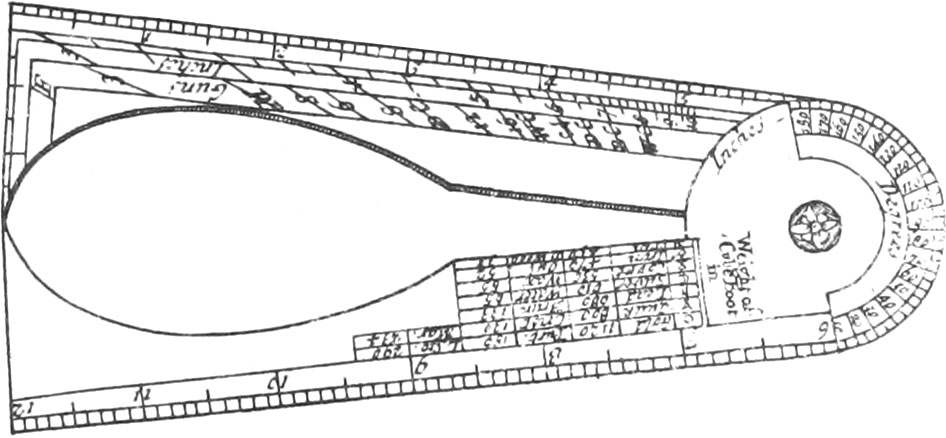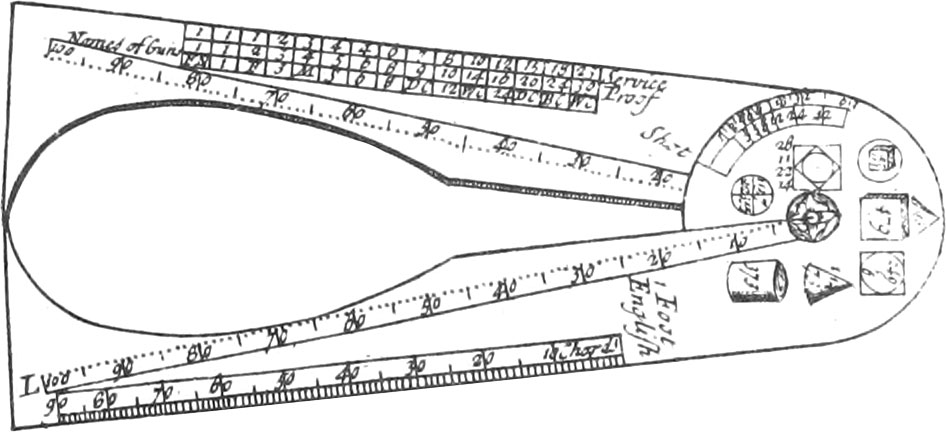These Callipers, or Gunners Compasses, consist of two long thin Pieces of Brass, joined together by a Rivet in such a Manner, that one may move quite round the other. The Head or End of one of these Pieces is cut Circular, and the Head of the other Semi-Circular, the Center of which being the Center of the Rivet. The Length of each of those Pieces from the Center of the Rivet is six Inches; so that when the Callipers are quite opened, they are a Foot long.
One half of the Circumference of the Circular Head, is divided into every 2 Degrees, every tenth of which are numbered. And on part of the other half, beginning from the Diameter of the Semi-Circle, when the Points of the Callipers are close together, are Divisions from 1 to 10, each of which are likewise subdivided into four Parts. The Use of these Divisions and Subdivisions, is, that when you have taken the Diameter of any round thing, as a Cannon-Ball, not exceeding 10 Inches, the Diameter of the Semi-Circle will, amongst those Divisions, give the Length of that Diameter taken between the Points of the Callipers in Inches and 4th Parts.
From this Use, it is manifest how the aforesaid Divisions for Inches may be easily made: For, first, set the Points of the Callipers together, and then make a Mark for the Beginning of the Divisions; then open the Points one fourth of an Inch, and where the Diameter or the Semi-Circle cuts the Circumference, make a Mark for one fourth of an Inch. Then open the Points half an Inch, and where the Diameter of the Semi-Circle cuts the Circumference, make another Mark for half an Inch. In this Manner proceed for all the other Subdivisions and Divisions to Ten.
Upon one of the Branches, on the same Side the Callipers, are, First, half a Foot or six Inches, each subdivided into ten Parts: Secondly, a Scale of unequal Divisions, beginning at two, and ending at ten, each of which are subdivided into four Parts. The Construction of this Scale or Lines will be very evident, when it’s Use is shewn, which is thus: If you have a Mind to find how many Inches, under 10, the Diameter of any Concave, as the Diameter of the Bore of any Piece of Ordnance is in length, you must open the Branches of the Callipers, so that the two Points may be outwards; then taking the Diameter between the said Points see what Division, or Subdivision, the outward Edge of the Branch with the Semi-circular Head, cuts on the aforesaid Scale of Lines, and that will be the Number of Inches, or Parts, the Diameter of the Bore of the Piece is in Length. Therefore the Divisions on this Scale may be made in the same Manner as I have before directed, in shewing how to make these Divisions for finding the Diameters of round Convex Bodies.
Thirdly, The two other Scales of Lines on the same Face of the same Branch, shew when the Diameter of the Bore of a Piece of Cannon is taken with the Points of the Callipers outward, the Name of the Piece, whether Iron or Brass, that is, the Weight of the Bullets they carry, or such and such a Pounder, from 42 Pounds to 1. The Construction of these Scales are from experimental Tables in Gunnery.
On the other Branch, the same Side of the Callipers, is, First, six Inches, every of which is subdivided into 10 Parts. Secondly, A Table shewing the Weight of a Cubic Foot of Gold, Quick-silver, Lead, Silver, Copper, Iron, Tin, Purbec-Stone, Chrystal, Brimstone, Water, Wax, Oil, and dry Wood.

